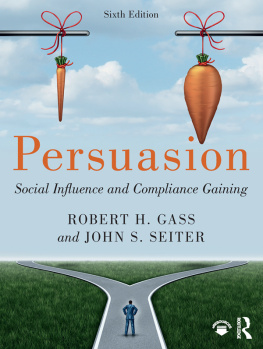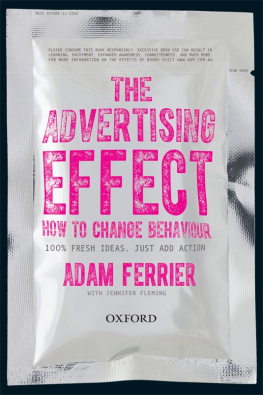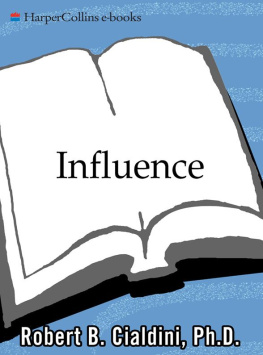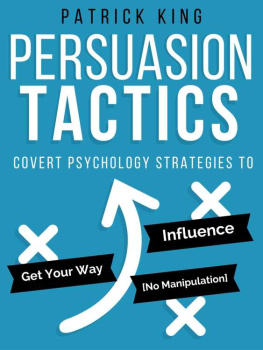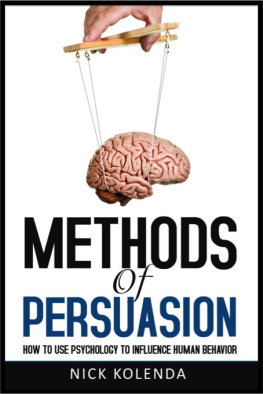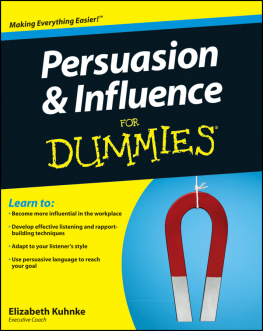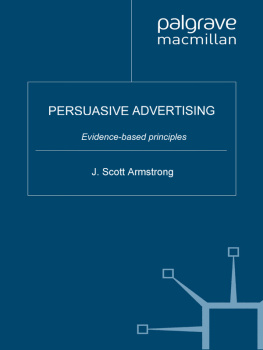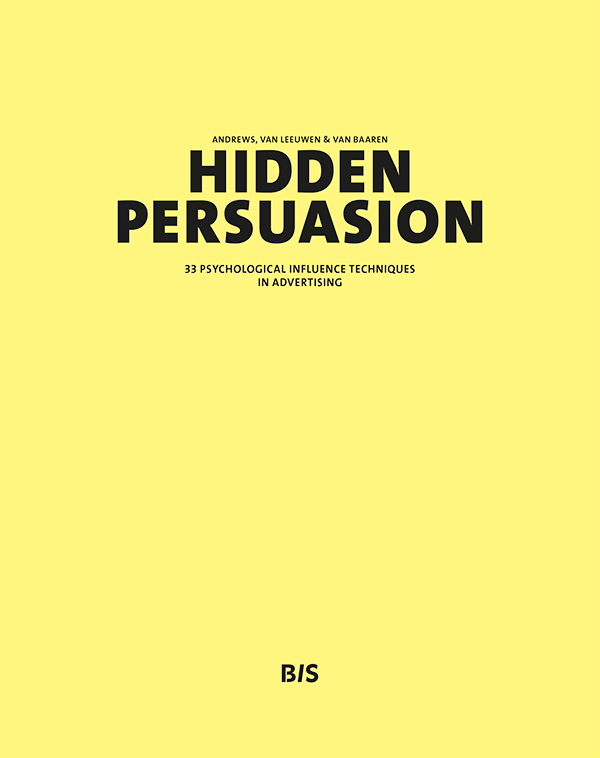BIS Publishers
Building Het Sieraad
Postjesweg 1
1057 DT Amsterdam
The Netherlands
T +31 (0)20 515 02 30
F +31 (0)20 515 02 39
bis@bispublishers.nl
www.bispublishers.nl
Design
andrews:degen,
Amsterdam
Typefaces
The Sans, Ingeborg
Cover Photo
Ralf Mitsch
ISBN 978 90 6369 314 5
EISBN 978 90 6369 3831
Copyright 2013
Marc Andrews, Dr. van Leeuwen,
Prof. Dr. van Baaren and BIS Publishers.
All rights reserved. No part of this publication may be reproduced or transmitted in any form or by any means, electronic or mechanical, including photocopy, recording or any information storage and retrieval system, without permission in writing from the copyright owners. Every reasonable attempt has been made to identify owners of copyright. Any errors or omissions brought to the publisher's attention will be corrected in subsequent editions.
DEDICATED TO YOU,
THE CONSUMER
Advertising is omnipresent in our daily lives. We are exposed to hundreds or even thousands of visual persuasive messages each day. Constantly, these messages attempt to persuade us to feel, believe, act, buy, and to change ourselves. These visual messages reach us at all times and in all kinds of private and public settings, offline as well as online. Fortunately, we lack the ability to process all of this information in a conscious way. Still, some of these carefully constructed visual messages succeed in affecting our attitudes and behaviours more than others, most of the time unconsciously. What is their hidden persuasive force?
Why are we influenced to buy one product over another? How are we stimulated to act and live more sustainably? How are we persuaded to adopt healthier lifestyles?
Throughout this book, advertising is analysed beyond the persuasive power of its imagery. We examine the techniques and concepts hidden behind the visual and aesthetic dimensions of advertising. Advertising is decoded from a psychological point of view, unveiling the hidden unconscious codes that influence our daily decisions.
In this book, 33 social influence techniques are presented based on the latest persuasion and compliance research. The techniques range from influence essentials to more obscure and insidious ones. We describe the underlying processes and techniques that guide our decisions, behaviours, and beliefs. By reading this book, the reader will gain deep insights into how visual means are constructed to influence people on an unconscious level.
In the world of social influence, there are several, diverse techniques that can steer people in the desired direction. The origins of social influence are mainly from the fields of rhetoric, obedience, and one-on-one sales. Out of that secret garden, we have selected the techniques that form the backbone of successful advertising.
Now, for the first time, there is a publication that presents a clear overview of social influence techniques used in advertising, enriched with many examples and illustrations. The selected commercials and social advertisements illustrate the techniques visually, which helps the reader to understand how these somewhat abstract concepts are applied in visual communications.
This book is designed as an accessible modern reference book for creating and understanding persuasive visual imagery, making this resource available and comprehensible to a wide range of people.
After reading this book, you will look at advertising differently whether you are a communication professional, an art director, designer, marketer, businessperson, manager, trader, student, or just a consumer like each of us! In the end, we are all persuaders and targets of persuasion.
This book will open your eyes to the tricks of the trade, we guarantee it!
Three needs
The techniques in this book are based on three classes of our most basic needs. These are the source of our vulnerability to hidden persuasion. When advertisers use imagery and language that taps into these needs, the audience is unable to fully resist the persuasive power of the message.

1. System needs
Our cognitive system has evolved from the simplest single cell organism to the advanced brain we use today for conscious analyses, language, and selfreflection. Still ingrained in us, however, are hardwired mental shortcuts that trigger behaviours beyond our control like the fight-or-flight response we experience when seeing a predatory animal heading straight for us. Advertisements that target these automatic processes have their desired effects before the information becomes available for conscious deliberation. This is the most basic and uncontrollable of the three needs.

2. Social needs
Humans are social animals; we all want to be loved and respected by friends and strangers alike. Critically, in the past, being cast out from the group posed great danger to individuals, and the fear of social exclusion still lingers in modern man. Other people and their opinions, behaviours, and appearances continue to be some of the most important stimuli we process and one of the biggest influences on our own thoughts, motivations, and behaviours. In this highly demanding and informationally overwhelming world even though we strongly believe ourselves to be free individuals we look to others for guidance more than ever. As such, advertisers have an easy task of tapping into our needs for social inclusion and conformity.

3. Self needs
Third are the needs we usually feel as being most important: our personal needs. We avoid pain and strive for pleasure; we want wealth, good food, a stable income, and (most of all) safety. Consciously, we try to make the best decisions so that our future self will be content and out of (physical and psychological) danger. This last need is catered to by advertisements using techniques that help project an illusion of a safe and sated, worry-free future.
How to use
Read from beginning to end, jump from technique to technique, or just explore the ads and their explanatory captions. There is no right or wrong way to do it; just dive in and get surprised! To get you started, here's an overview of what information you can expect to find.

1
Name and number of technique
2
Icons
Shows you which of the three needs (self, social, or system) the technique employs.
3
Main text
Explains the technique, the circumstances under which it works and why, as well as the dos and don'ts and how-to tips for applying the technique. Scientific sources can be found in the back of the book. We have also included a list of other additional interesting and inspiring books related to the fields of psychology, social influence, communication, design, visual rhetoric, and advertising.





